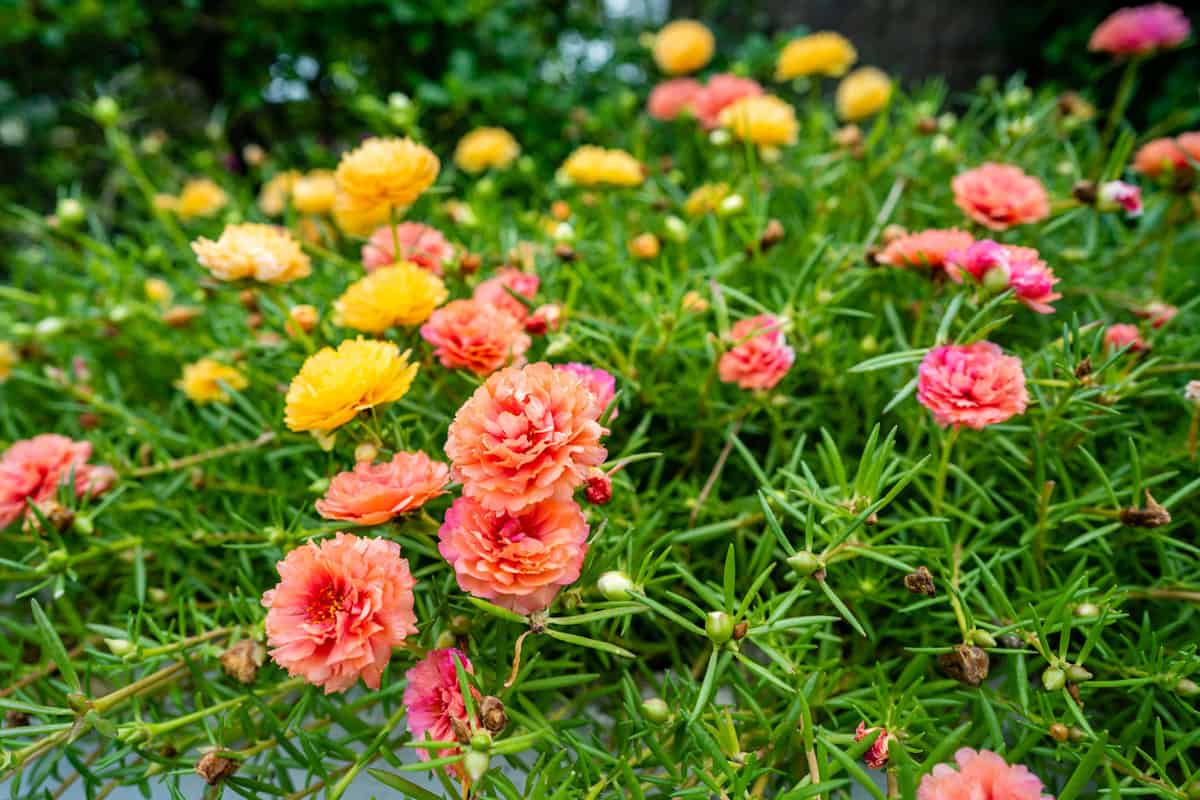
Portulaca, also known as Purslane, is a fascinating and versatile plant that has been gaining popularity among garden enthusiasts and health-conscious individuals. This succulent plant belongs to the Portulacaceae family and is native to hot and dry regions. With its vibrant colors and low maintenance requirements, Portulaca makes a beautiful addition to garden beds, rock gardens, or even hanging baskets.
But Portulaca is more than just a pretty face. It has a rich history and boasts a unique set of characteristics that sets it apart from other plant species. In this article, we’ll explore 18 intriguing facts about Portulaca, from its medicinal uses to its ability to survive in extreme conditions. Whether you’re a gardening enthusiast or simply curious about the wonders of nature, you’re sure to find these facts about Portulaca captivating. So, let’s dive in and unearth the secrets of this remarkable plant!
Key Takeaways:
- Portulaca, also known as purslane, is a resilient plant with vibrant flowers and edible leaves, making it a perfect choice for gardens and landscapes in dry and hot regions.
- With its ability to self-seed, attract beneficial insects, and thrive in challenging conditions, Portulaca is a versatile and low-maintenance plant that adds beauty and resilience to any outdoor space.
Portulaca, also known as purslane, is a flowering plant that belongs to the family Portulacaceae.
Portulaca is a genus of succulent plants that are native to hot and dry regions of the world. It is appreciated for its vibrant colors and ability to thrive in challenging conditions.
There are over 100 species of Portulaca, with the most common being Portulaca oleracea.
Portulaca oleracea, commonly known as common purslane, is a widely distributed species that is used as a culinary and medicinal herb in many parts of the world. It has small, fleshy leaves and yellow flowers.
Portulaca is known for its succulent and fleshy leaves that retain water, allowing it to withstand drought conditions.
The leaves of Portulaca are thick and juicy, acting as water reservoirs for the plant. This adaptation enables Portulaca to survive in arid environments where other plants struggle to grow.
Portulaca flowers bloom in a variety of vibrant colors, including shades of pink, red, orange, yellow, and white.
The colorful flowers of Portulaca attract pollinators such as bees and butterflies. They typically bloom during the summer months, adding a splash of color to gardens and landscapes.
Portulaca is often used as ground cover due to its spreading habit and ability to form dense mats of foliage.
With its low-growing and spreading nature, Portulaca is an excellent choice for ground cover in gardens and landscaping projects. It can quickly fill in bare areas, preventing weed growth and erosion.
Portulaca is edible and has been used as a food source for centuries, particularly in Mediterranean and Asian cuisine.
Its leaves, stems, and flower buds are all edible and have a slightly tangy and lemony flavor. Portulaca is rich in nutrients such as omega-3 fatty acids, vitamins A, C, and E, and minerals like magnesium and potassium.
Portulaca has been used in traditional medicine to treat various ailments, including skin conditions, digestive issues, and respiratory problems.
The medicinal properties of Portulaca have been recognized for centuries. It has been used as a natural remedy to heal wounds, soothe skin irritations, relieve gastrointestinal disorders, and ease respiratory symptoms.
Portulaca is easy to grow and is often cultivated as an ornamental plant.
Due to its low maintenance requirements and ability to thrive in various climates, Portulaca is a popular choice among gardeners. It can be grown from seeds or cuttings and is well-suited for containers, hanging baskets, or rock gardens.
Portulaca is an excellent choice for xeriscaping, a landscaping method that focuses on water conservation.
With its ability to tolerate drought conditions, Portulaca is often incorporated into xeriscape gardens. It reduces the need for excessive watering and helps conserve water resources in areas prone to dry spells.
Portulaca is sometimes called the “ten o’clock flower” because its flowers open around 10 a.m. and close in the afternoon.
The flowers of Portulaca have a unique opening and closing time, adding an element of fascination to the plant. They open up during the morning hours, revealing their vibrant colors, and close in the afternoon or on cloudy days.
Portulaca seeds are often dispersed by ants, which are attracted to the nutritious appendages on the seed coat.
Portulaca has a clever mechanism to ensure its seeds are spread. The seeds have ant-attracting structures called elaiosomes, which provide food for ants. The ants carry the seeds to their nests, inadvertently aiding in seed dispersal.
Portulaca is not only beautiful but also environmentally friendly, as it attracts beneficial insects like bees and butterflies.
The vibrant flowers of Portulaca act as a magnet for pollinators, which play a crucial role in plant reproduction and ecosystem health. By attracting bees and butterflies, Portulaca contributes to the overall biodiversity and balance of the surrounding environment.
Portulaca is resistant to many common plant diseases and pests.
Portulaca’s succulent leaves and stems have a natural wax-like coating that helps protect them from pests and diseases. This resilience makes Portulaca a low-maintenance plant that requires minimal intervention to thrive.
Portulaca has a long history of cultural significance and has been referenced in ancient folklore and literature.
Throughout history, Portulaca has been associated with various symbols and meanings. In ancient folklore, it was believed to possess properties of protection and luck. It has also been mentioned in literature, poetry, and art, showcasing its enduring appeal.
Portulaca is a popular choice for rock gardens and can thrive in dry, rocky soil conditions.
Due to its ability to adapt to poor soil conditions, Portulaca is an ideal plant for rock gardens or areas with minimal soil. Its spreading growth habit and attractive flowers make it a perfect addition to the rocky landscape.
Portulaca plants have shallow root systems that spread horizontally rather than growing deep into the ground.
The shallow root system of Portulaca enables it to quickly absorb water after rainfall or irrigation. It also allows the plant to adapt to different soil types, including sandy or loamy soils.
Portulaca plants are self-seeding, meaning they can produce new plants from dropped seeds.
Once established, Portulaca can self-seed and produce new plants without any human intervention. This natural ability contributes to its resilience and ability to colonize new habitats.
Portulaca is a versatile plant and has been used in various landscape applications, including vertical gardens and rooftop gardens.
The adaptability of Portulaca makes it suitable for innovative gardening techniques such as vertical gardens and rooftop gardens. Its trailing habit and vibrant flowers add beauty and color to these urban garden settings.
Conclusion
Portulaca, also known as purslane or moss rose, is a fascinating plant with a rich history and a variety of intriguing facts. From its ability to thrive in harsh conditions to its health benefits and culinary uses, there is so much to discover about this remarkable plant.
Whether you are a gardening enthusiast looking to add some color and resilience to your landscape or someone interested in exploring its medicinal properties, Portulaca is sure to impress. With its vibrant flowers, succulent leaves, and low-maintenance nature, it is a versatile and attractive addition to any garden or outdoor space.
So next time you come across Portulaca, take a moment to appreciate its beauty and remember these interesting facts about this remarkable plant.
FAQs
1. What are some common varieties of Portulaca?
Portulaca comes in a variety of colors and forms. Some popular cultivars include Portulaca grandiflora (commonly known as moss rose) and Portulaca oleracea (known as common or garden purslane).
2. How do you care for Portulaca plants?
Portulaca requires minimal care. It thrives in full sun and well-drained soil, making it ideal for hot and dry climates. Water sparingly as it is drought-tolerant, and avoid overwatering to prevent root rot.
3. Can Portulaca be grown indoors?
While Portulaca is mainly grown outdoors, it can be cultivated indoors in a sunny and well-ventilated location. Ensure that the soil is well-drained, and water sparingly to avoid excessive moisture.
4. Are there any health benefits associated with Portulaca?
Yes, Portulaca is known for its health benefits. It is a rich source of omega-3 fatty acids, antioxidants, vitamins, and minerals. It is believed to have anti-inflammatory properties and can aid in improving heart health and boosting the immune system.
5. Is Portulaca edible?
Yes, Portulaca is edible, and its leaves and stems can be consumed either raw or cooked. It is commonly used in salads, stir-fries, and soups. However, ensure that the plant is grown organically and not treated with any harmful chemicals.
Was this page helpful?
Our commitment to delivering trustworthy and engaging content is at the heart of what we do. Each fact on our site is contributed by real users like you, bringing a wealth of diverse insights and information. To ensure the highest standards of accuracy and reliability, our dedicated editors meticulously review each submission. This process guarantees that the facts we share are not only fascinating but also credible. Trust in our commitment to quality and authenticity as you explore and learn with us.


